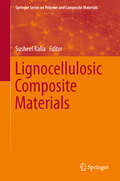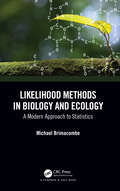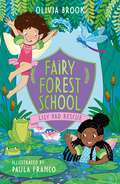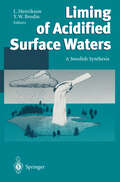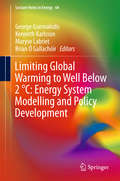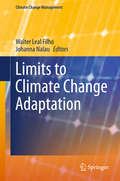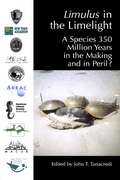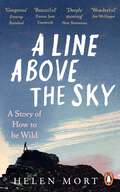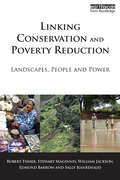- Table View
- List View
Lignin: Biosynthesis and Transformation for Industrial Applications (Springer Series on Polymer and Composite Materials)
by Swati Sharma Ashok KumarThis book presents a comprehensive overview on origin, structure, properties, modification strategies and applications of the biopolymer lignin. It is organized into four themed parts. The first part focuses on the analysis and characterization of the second most abundant biopolymer. The following part is devoted to the biological aspects of lignin such as biosynthesis and degradation. In the third part, chemical modification strategies and the preparation of composites as well as nano- and microparticles are discussed.The final part addresses the industrial application of lignin and its derivatives, as well as lignin materials. The usage for synthesis of biofuels, fine chemicals and in agriculture and food industry is covered.This book is a comprehensive source for researchers, scientists and engineers working in the field of biopolymers as well as renewable materials and sources.
Lignocellulosic Composite Materials (Springer Series on Polymer and Composite Materials)
by Susheel KaliaThis book comprehensively summarizes important aspects of research in the active field of lignocellulosic (polymer) composites, including polymer materials from or containing cellulose, hemicellulose and lignin. It describes how these materials can be produced from forest products and natural fibers from sources such as jute, flax, sisal, and many more, and even from agricultural residues (like wheat straw, corn stover, or sugarcane bagasse). In times of high demand for renewable green materials, lignocellulosic materials from organic matter produced by trees, shrubs and agricultural crops present a highly attractive feedstock.The international authors explain different treatment and fabrication methods for the production of lignocellulosic materials. Other chapters address the properties of these green materials or illustrate specific applications, ranging from food packaging and household products to adsorbents and even conductive polymer composites. In this way, this book offers a broad and comprehensive overview over the entire field of lignocellulosic composite materials.
Likelihood Methods in Biology and Ecology: A Modern Approach to Statistics
by Michael BrimacombeThis book emphasizes the importance of the likelihood function in statistical theory and applications and discusses it in the context of biology and ecology. Bayesian and frequentist methods both use the likelihood function and provide differing but related insights. This is examined here both through review of basic methodology and also the integr
Likelihood Methods in Biology and Ecology: A Modern Approach to Statistics
by Michael BrimacombeThis book emphasizes the importance of the likelihood function in statistical theory and applications and discusses it in the context of biology and ecology. Bayesian and frequentist methods both use the likelihood function and provide differing but related insights. This is examined here both through review of basic methodology and also the integr
Lily and the Polar Bears
by Jion SheibaniOne evening, Lily is playing on the beach. And who should float in, but LOTS of polar bears! Lily is excited to welcome them home for dinner (of fish fingers and ice cream, of course) and to have them stay for a sleepover. Lily has even more fun with the bears when they go swimming, ice skating, and visit the fun fair - and it soon turns out that polar bears are really quite good at a lot things, becoming polar bear postmen, opening ice cream parlours, and even becoming astronauts!
Lily Pad Rescue: Book 4 (Fairy Forest School #4)
by Olivia BrookA magical fairy school series about helping animals and looking after nature, from the publisher of the best-selling series, Rainbow Magic!Poppy Merrymoss is competing in the Lily Pad Lake swimming gala with her best friends Rose Seedpip and Ninad Cleardrop. But nasty Lady Nightshade is determined to ruin the event and fills the lake with a thick algae that covers the swimmers in slimy green gunk. And even worse, the thick algae has trapped a frog family beneath the slime!Can Poppy and her friends clean the lake in time to save the frogs - and the gala?Have you read Poppy Merrymoss's previous adventures, Fairy Forest School: The Raindrop Spell, Fairy Forest School: Baby Bunny Magic and Fairy Forest School: The Snowflake Charm?
Liming of Acidified Surface Waters: A Swedish Synthesis
by Lennart Henrikson Y. W. BrodinAcidification is one of the most serious environmental problems - especially in Sweden, which suffers most from the consequences of acid rain. Besides international negotiations to reduce sulphur emissions - 85% of the acid load on Sweden can be traced to emissions from outside the country itself - the Swedish Government has employed large-scale, operative liming activities to counteract acidification of surface waters. The scientific results show that - although acidification cannot be solved by liming alone - the measures taken resulted in substantial improvements to around 8,000 Swedish lakes and watercourses. The idea is that other countries affected by acidification may also profit from this experience.
Limit Analysis Theory of the Soil Mass and Its Application
by Chuanzhi HuangThis book establishes the equations of limit analysis and provides a complete theoretical basis for foundation capacity, slope stability, and earth pressure. It is divided into three parts, the first of which discusses the failure mode and fundamental equation of soil mass. The second part addresses the solution methods for limit analysis, including the characteristic line method, stress field method, limit equilibrium method, virtual work equation-based generalized limit equilibrium method and generalized limit equilibrium method for the surface failure mode. Lastly, the third part examines the application of the limit analysis theory to soil mass.
Limiting Global Warming to Well Below 2 °C: Energy System Modelling and Policy Development (Lecture Notes in Energy #64)
by George Giannakidis Kenneth Karlsson Maryse Labriet B. Ó GallachóirThis book presents the energy system roadmaps necessary to limit global temperature increase to below 2°C, in order to avoid the catastrophic impacts of climate change. It provides a unique perspective on and critical understanding of the feasibility of a well-below-2°C world by exploring energy system pathways, technology innovations, behaviour change and the macro-economic impacts of achieving carbon neutrality by mid-century. The transformative changes in the energy transition are explored using energy systems models and scenario analyses that are applied to various cities, countries and at a global scale to offer scientific evidence to underpin complex policy decisions relating to climate change mitigation and interrelated issues like energy security and the energy–water nexus. It includes several chapters directly related to the Nationally Determined Contributions proposed in the context of the recent Paris Agreement on Climate Change. In summary, the book collates a range of concrete analyses at different scales from around the globe, revisiting the roles of countries, cities and local communities in pathways to significantly reduce greenhouse gas emissions and make a well-below-2°C world a reality. A valuable source of information for energy modellers in both the industry and public sectors, it provides a critical understanding of both the feasibility of roadmaps to achieve a well-below-2°C world, and the diversity and wide applications of energy systems models. Encompassing behaviour changes; technology innovations; macro-economic impacts; and other environmental challenges, such as water, it is also of interest to energy economists and engineers, as well as economic modellers working in the field of climate change mitigation.
Limits: Why Malthus Was Wrong and Why Environmentalists Should Care
by Giorgos KallisWestern culture is infatuated with the dream of going beyond, even as it is increasingly haunted by the specter of apocalypse: drought, famine, nuclear winter. How did we come to think of the planet and its limits as we do? This book reclaims, redefines, and makes an impassioned plea for limits—a notion central to environmentalism—clearing them from their association with Malthusianism and the ideology and politics that go along with it. Giorgos Kallis rereads reverend-economist Thomas Robert Malthus and his legacy, separating limits and scarcity, two notions that have long been conflated in both environmental and economic thought. Limits are not something out there, a property of nature to be deciphered by scientists, but a choice that confronts us, one that, paradoxically, is part and parcel of the pursuit of freedom. Taking us from ancient Greece to Malthus, from hunter-gatherers to the Romantics, from anarchist feminists to 1970s radical environmentalists, Limits shows us how an institutionalized culture of sharing can make possible the collective self-limitation we so urgently need.
The Limits of the Green Economy: From re-inventing capitalism to re-politicising the present (Routledge Studies in Environmental Policy)
by Anneleen Kenis Matthias LievensProjecting win-win situations, new economic opportunities, green growth and innovative partnerships, the green economy discourse has quickly gained centre stage in international environmental governance and policymaking. Its underlying message is attractive and optimistic: if the market can become the tool for tackling climate change and other major ecological crises, the fight against these crises can also be the royal road to solving the problems of the market. But how ‘green’ is the green economy? And how social or democratic can it be? This book examines how the emergence of this new discourse has fundamentally modified the terms of the environmental debate. Interpreting the rise of green economy discourse as an attempt to re-invent capitalism, it unravels the different dimensions of the green economy and its limits: from pricing carbon to emissions trading, from sustainable consumption to technological innovation. The book uses the innovative concept of post-politics to provide a critical perspective on the way green economy discourse represents nature and society (and their interaction) and forecloses the imagination of alternative socio-ecological possibilities. As a way of repoliticising the debate, the book advocates the construction of new political faultlines based on the demands for climate justice and democratic commons. This book will be of interest to students and scholars of environmental politics, political ecology, human geography, human ecology, political theory, philosophy and political economy. Includes a foreword written by Erik Swyngedouw (Professor of Geography, Manchester University).
The Limits of the Green Economy: From re-inventing capitalism to re-politicising the present (Routledge Studies in Environmental Policy)
by Anneleen Kenis Matthias LievensProjecting win-win situations, new economic opportunities, green growth and innovative partnerships, the green economy discourse has quickly gained centre stage in international environmental governance and policymaking. Its underlying message is attractive and optimistic: if the market can become the tool for tackling climate change and other major ecological crises, the fight against these crises can also be the royal road to solving the problems of the market. But how ‘green’ is the green economy? And how social or democratic can it be? This book examines how the emergence of this new discourse has fundamentally modified the terms of the environmental debate. Interpreting the rise of green economy discourse as an attempt to re-invent capitalism, it unravels the different dimensions of the green economy and its limits: from pricing carbon to emissions trading, from sustainable consumption to technological innovation. The book uses the innovative concept of post-politics to provide a critical perspective on the way green economy discourse represents nature and society (and their interaction) and forecloses the imagination of alternative socio-ecological possibilities. As a way of repoliticising the debate, the book advocates the construction of new political faultlines based on the demands for climate justice and democratic commons. This book will be of interest to students and scholars of environmental politics, political ecology, human geography, human ecology, political theory, philosophy and political economy. Includes a foreword written by Erik Swyngedouw (Professor of Geography, Manchester University).
Limits of the Numerical: The Abuses and Uses of Quantification
by Christopher Newfield Stephen John Anna AlexandrovaThis collection examines the uses of quantification in climate science, higher education, and health. Numbers are both controlling and fragile. They drive public policy, figuring into everything from college rankings to vaccine efficacy rates. At the same time, they are frequent objects of obfuscation, manipulation, or outright denial. This timely collection by a diverse group of humanists and social scientists challenges undue reverence or skepticism toward quantification and offers new ideas about how to harmonize quantitative with qualitative forms of knowledge. Limits of the Numerical focuses on quantification in several contexts: climate change; university teaching and research; and health, medicine, and well-being more broadly. This volume shows the many ways that qualitative and quantitative approaches can productively interact—how the limits of the numerical can be overcome through equitable partnerships with historical, institutional, and philosophical analysis. The authors show that we can use numbers to hold the powerful to account, but only when those numbers are themselves democratically accountable.
Limits to Climate Change Adaptation (Climate Change Management)
by Walter Leal Filho Johanna NalauThis book sheds new light on the limits of adaptation to anthropogenic climate change. The respective chapters demonstrate the variety of and interconnections between factors that together constitute the constraints on adaptation. The book pays special attention to evidence that illustrates how and where such limits have become apparent or are in the process of establishing themselves, and which indicates future trends and contexts that might prove helpful in understanding adaptation limits. In particular, the book provides an overview of the most important challenges and opportunities regarding adaptation limits at different temporal, jurisdictional, and spatial scales, while also highlighting case studies, projects and best practices that show how they may be addressed. The book presents innovative multi-disciplinary research and gathers evidence from various countries, sectors and regions, the goal being to advance our understanding of the limits to adaptation and ways to overcome or modify them.
Limnology
by Jose Galizia Tundisi Takako Matsumura TundisiLimnology provides an in-depth and current overview of the field of limnology. The result of a major tour de force by two renowned and experienced experts, this unique and richly illustrated reference presents a wealth of data on limnology history, water as a substrate, lakes' origins and aquatic biota. Besides a general part, it gives special focu
Limnology and Aquatic Birds: Proceedings of the Fourth Conference Working Group on Aquatic Birds of Societas Internationalis Limnologiae (SIL), Sackville, New Brunswick, Canada, August 3-7, 2003 (Developments in Hydrobiology #189)
by Alan R. Hanson Joseph J. KerekesLong-term population monitoring is an important tool in our investigations of the role waterbirds play in their environment. This book is international in scope and presents information on species as diverse as the Common Loon, Harlequin Duck, and Semi-Palmated Sandpiper, and habitat in locations ranging from Iceland to Japan. Papers presented in this volume further our understanding of the important role that limnology plays in determining habitat suitability for waterbirds.
Limnoperna Fortunei: The Ecology, Distribution and Control of a Swiftly Spreading Invasive Fouling Mussel (Invading Nature - Springer Series in Invasion Ecology #10)
by Demetrio BoltovskoyThis book summarizes all currently available information on the ecology, environmental impacts and control methods of the golden mussel in industrial plants. The golden mussel was introduced in Hong Kong, Taiwan, Japan, and South America between 1965 and 1990, swiftly spreading in freshwater waterbodies. In most areas invaded it has become the dominant macroinverebrate and a major fouling pest of industrial plants. Limnoperna fortunei attaches to any hard surface, as well as to some less firm substrates. The growth of Limnoperna populations in raw cooling water conduits became a common nuisance in many industrial and power plants that use raw river or lake water for their processes, both in South America and in Asia. This work is written by experts on the golden mussel from Asia, Europe, North America and South America, each chapter critically reviews previously available information, which is in sources of limited distribution, such as internal reports and theses, in various languages.
Limulus in the Limelight: A Species 350 Million Years in the Making and in Peril?
by John T. TanacrediLimulus in the Limelight: A Species 350 Million Years in the Making and in Peril? contains 14 chapters covering the horseshoe crab's biology, ecology and evolutionary development. The book is a result of three mini-conferences held between 1996 and 2000 celebrating the populations in NY harbor. This book exposes the impacts of over fishing on this species; clarifies the future research agenda for the species worldwide and emphasizes the need for conservation of this fascinating creature's estuaries/ocean habitats. Biologists, ecologists, science educators, and conservationists will welcome this book because it is aimed at the preservation of Limulus, not only for its pharmacological interest but for the mystery related to its longevity. Limulus is a unique animal which has provided numerous uses for man over the years, from fertilizer to bait to medical research. However, if this species is not protected soon, it will be lost for the future.
A Line Above the Sky: On Mountains and Motherhood
by Helen MortGuardian Books to Watch 2022Evening Standard Books to Watch 2022Bookseller Editor's Choice'A wonderful book - exhilarating and taut, fearless in its explorations of wildness, risk, motherhood, and the inner and outer worlds of the writer' Jon McGregor'This book is beautiful' Emma Jane UnsworthClimbing gives you the illusion of being in control, just for a while, the tantalising sense of being able to stay one move ahead of death. Helen Mort has always been drawn to the thrill and risk of climbing: the tension between human and rockface, and the climber's powerful connection to the elemental world. But when she becomes a mother for the first time, she finds herself re-examining her relationship with both the natural world and herself, as well as the way the world views women who aren't afraid to take risks. A Line Above the Sky melds memoir and nature writing to ask why humans are drawn to danger, and how we can find freedom in pushing our limits. It is a visceral love letter to losing oneself in physicality, whether climbing a mountain or bringing a child into the world, and an unforgettable celebration of womanhood in all its forms.
A Line in the World: A Year on the North Sea Coast
by Dorthe NorsAn exhilarating and intelligent book that explores the magnetic attraction of the austere Danish coast, and the author's connection to this magnificent and raw landscape'A beautiful, melancholy account of finding home on a restless coast. I loved it.' KATHERINE MAY, AUTHOR OF WINTERINGMe, my notebook and my love of the wild and desolate. I wanted to do the opposite of what was expected of me. It's a recurring pattern in my life. An instinct.There is a line that stretches from the northernmost tip of Denmark to where the Wadden Sea meets Holland in the south-west. Dorthe Nors, one of Denmark's most acclaimed writers, is a descendant of this line; for generations, her family lived among the storm-battered trees and wind-blasted beaches of the North Sea coast. Returning after decades of inhabiting cities, she chronicles a year spent travelling up and down the coast, tracing the history and geography of the places she visits and untangling her relationship with the landscape she calls home.This is the story of the violent collisions between the people who live in these wild places and the vagaries of the natural world. It is a story of shipwrecks and storm surges, of cold-water surfers, sun-creased beach mums and resolute sailor's wives. In spellbinding prose, Nors invites the reader on a journey through history and memory - the landscape's as well as her own.
Linescapes: Remapping and Reconnecting Britain's Fragmented Wildlife
by Hugh Warwick‘Glorious… Political, passionate, perceptive’ Robert MacfarlaneAn eye-opening exploration of the lines that cut through our countryside, from hedges to railways, and a passionate manifesto for reconnecting wildlife.Our landscape has been transformed by a vast network of lines, from hedges and walls to railways and power cables. In Linescapes, Hugh Warwick unravels the far-reaching ecological consequences of these changes. As our lives and our land were fenced in and threaded together, wildlife habitats were cut into ever smaller – and increasingly unviable – fragments. Yet as Warwick travels across this linescape, he shows that we can help our flora and fauna to flourish once again. With his fresh and bracing perspective on Britain’s countryside, he proposes a challenge and gives ground for hope, for our lines can and do contain a real potential for wildness and for wildlife.
Linking Conservation and Poverty Reduction: Landscapes, People and Power
by Robert Fisher Stewart Maginnis William Jackson Edmund Barrow Sally Jeanrenaud'This book aims to inspire the conservation community not to regard poverty reduction as someone else's job but to take responsibility for it as part of ecosystem restoration. Though no solutions are perfect,the text and examples given offer encouraging and useful guidance.' Gill Shepherd, poverty and landscapes thematic leader, IUCN Forest Conservation Programme. 'This book could be the catalyst for a real paradigm shift - not just in capital cities and international conference centres, but also on the ground in locations where poor people are struggling to make a living.' Policy Matters (praise for the first edition). High levels of rural poverty in many of the world's ecosystems make it an ethical and practical imperative to find more equitable and realistic ways of achieving conservation. Livelihoods of the rural poor and options for conservation and sustainable use of biological diversity are so intimately entwined that they are better addressed through an integrated approach, irrespective of whether the primary motivation is one of development or one of conservation. This highly accessible book, a revised edition of the 2005 book Poverty and Conservation: Landscapes, People and Power, offers a grand overview of the issues and a conceptual framework for addressing poverty reduction in the context of conservation, and conservation in the context of poverty reduction. It will appeal to professionals working in the field as well as to students across the fields of conservation, development and sustainability. It looks at the rationale for addressing the links between conservation and poverty reduction, arguing that such a focus is both ethically essential and a source of opportunities. It alsoreviews experiences in dealing with people and conservation and identifies some key lessons and concepts. The book presents cases studies illustrating various approaches and a discussion of some of the issues that appear when implementing combined conservation and poverty reduction. The book emphasizes the importance of multiple spatial scales and negotiating trade-offs between scales. It also tackles the complex issue of institutional landscapes and the way in which changes at various institutional levels can lead to different and often more positive outcomes. The Final part summarizes some of the main features of the authors' integrated approach and identifies some of the challenges involved in efforts to combine conservation and poverty reduction. Published with IUCN - The World Conservation Union.
Linking Conservation and Poverty Reduction: Landscapes, People and Power
by Robert Fisher Stewart Maginnis William Jackson Edmund Barrow Sally Jeanrenaud'This book aims to inspire the conservation community not to regard poverty reduction as someone else's job but to take responsibility for it as part of ecosystem restoration. Though no solutions are perfect,the text and examples given offer encouraging and useful guidance.' Gill Shepherd, poverty and landscapes thematic leader, IUCN Forest Conservation Programme. 'This book could be the catalyst for a real paradigm shift - not just in capital cities and international conference centres, but also on the ground in locations where poor people are struggling to make a living.' Policy Matters (praise for the first edition). High levels of rural poverty in many of the world's ecosystems make it an ethical and practical imperative to find more equitable and realistic ways of achieving conservation. Livelihoods of the rural poor and options for conservation and sustainable use of biological diversity are so intimately entwined that they are better addressed through an integrated approach, irrespective of whether the primary motivation is one of development or one of conservation. This highly accessible book, a revised edition of the 2005 book Poverty and Conservation: Landscapes, People and Power, offers a grand overview of the issues and a conceptual framework for addressing poverty reduction in the context of conservation, and conservation in the context of poverty reduction. It will appeal to professionals working in the field as well as to students across the fields of conservation, development and sustainability. It looks at the rationale for addressing the links between conservation and poverty reduction, arguing that such a focus is both ethically essential and a source of opportunities. It alsoreviews experiences in dealing with people and conservation and identifies some key lessons and concepts. The book presents cases studies illustrating various approaches and a discussion of some of the issues that appear when implementing combined conservation and poverty reduction. The book emphasizes the importance of multiple spatial scales and negotiating trade-offs between scales. It also tackles the complex issue of institutional landscapes and the way in which changes at various institutional levels can lead to different and often more positive outcomes. The Final part summarizes some of the main features of the authors' integrated approach and identifies some of the challenges involved in efforts to combine conservation and poverty reduction. Published with IUCN - The World Conservation Union.
Linking Ecology and Ethics for a Changing World: Values, Philosophy, and Action (Ecology and Ethics #1)
by Ricardo Rozzi, S. T. A. Pickett, Clare Palmer, Juan J. Armesto and J. Baird CallicottTo comprehensively address the complexities of current socio-ecological problems involved in global environmental change, it is indispiseble to achieve an integration of ecological understanding and ethical values. Contemporary science proposes an inclusive ecosystem concept that recognizes humans as components. Contemporary environmental ethics includes eco-social justice and the realization that as important as biodiversity is cultural diversity, inter-cultural, inter-institutional, and international collaboration requiring a novel approach known as biocultural conservation. Right action in confronting the challenges of the 21st century requires science and ethics to be seamlessly integrated. This book resulted from the 14th Cary Conference that brought together leading scholars and practitioners in ecology and environmental philosophy to discuss core terminologies, methods, questions, and practical frameworks for long-term socio-ecological research, education, and decision making.
Linking Emissions Trading Schemes (Climate Policy Ser.)
by Andreas TuerkA growing number of GHG emissions trading schemes are being implemented at regional or national levels. However, even as the number of different schemes grows, few linkages exist between them. Major cap-and-trade proposals are currently at important stages in their development, especially in the United States, Japan and Australia, some of which explicitly emphasize the aim of linking with other schemes. One of the strategic goals of European climate policy is linking the EU ETS with other comparable schemes. The research presented in this volume is on actual economic, political and institutional constraints and implications. It examines the role of linking trading schemes for the development of the post-Kyoto climate architecture and for increasing linkage between schemes. This essential research will be relevant to both the scientific community and for policymakers who are involved in the design of emerging trading schemes and offset mechanisms, as well as in designing the post Kyoto climate regime. This volume focuses specifically on: o Economic, institutional/regulatory and legal dimensions of linking o Implications of linking on the design of emerging trading schemes o The role of linking trading schemes for the development of the post-Kyoto climate regime

